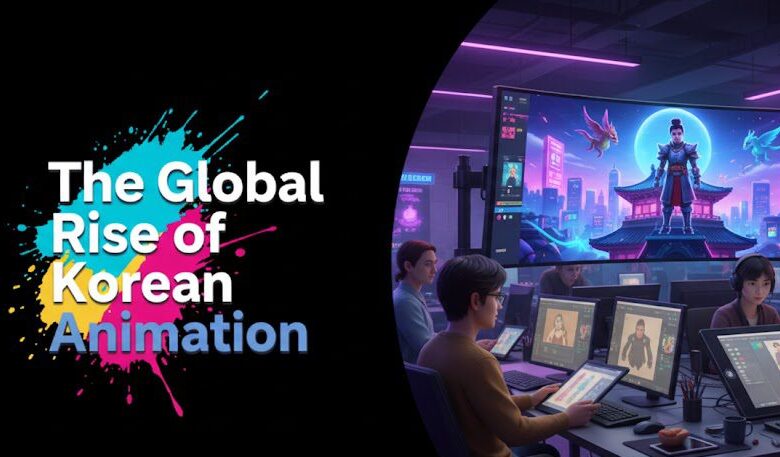The Global Rise of Korean Animation: A Strategic Guide for IP Acquisition and Co-Production

Introduction
For content acquisition, financing, and co-production executives, the challenge of securing globally resonant Intellectual Property (IP) has intensified as streaming platforms demand diverse, high-volume content.
While K-Drama and K-Pop have captured mass culture, the most critical strategic shift—the global emergence of aeni, or The Global Rise of Korean Animation—is now dictating new terms for the M&E supply chain.
This is not a cultural trend but an industrial force, driven by high production values, strategic government support, and an advanced understanding of cross-platform IP monetization.
To effectively capitalize on this growth, you require a strategic framework that moves beyond anecdotal successes and identifies the specific studios, financial drivers, and regulatory forces shaping the future of global animated content. Ignoring this sector is forfeiting a strategic advantage in the world’s fastest-growing content market.
Table of content
- The Global Rise of Korean Animation: Beyond K-Pop and K-Drama
- From Subcontracting Hub to Global IP Powerhouse: A Short History
- The Strategic Drivers Accelerating Korean Animation’s Global Reach
- Navigating Co-Production and IP Acquisition in Korean Animation
- The Essential Framework for Sourcing Korean Animation Partners
- How Vitrina Solves the Fragmented Data Problem for Strategic Partnership
- Conclusion: The Future of Aeni and Global M&E Strategy
- Frequently Asked Questions
Key Takeaways
| Core Challenge | Fragmented market data makes vetting Korean animation studios and securing clear IP rights a high-risk, inefficient process. |
| Strategic Solution | Employ an intelligence-driven approach to map partner scale, production track record, and IP ownership across the Korean M&E supply chain. |
| Vitrina’s Role | Vitrina provides verified, real-time data on Korean animation companies, their project pipeline, and collaboration history to de-risk investment and partnership decisions. |
The Global Rise of Korean Animation: Beyond K-Pop and K-Drama
The M&E investment thesis for South Korea is no longer limited to live-action formats. The South Korean “anime” market—a category which includes locally produced aeni—is projected to reach a revenue of US$3,743.0 million by 2030, exhibiting a compound annual growth rate (CAGR) of 11.5% from 2025 to 2030, according to data from Horizon Databook. This rapid expansion places the sector firmly in the domain of strategic asset acquisition.
The strategic significance of Korean animation is evidenced by its revenue segmentation. While the country’s animation industry developed initially through large-scale subcontracting for Japanese and Western animation houses, its modern revenue profile indicates a shift toward valuable, consumer-facing IP.
Merchandising remains the largest revenue segment, accounting for a 27.59% share in 2024, demonstrating the market’s reliance on tangible consumer products and ancillary rights.
Crucially, the Internet Distribution segment is simultaneously projected to be the fastest-growing category, signaling the effective monetization of content through subscription and ad-supported platforms globally.
For M&E executives focused on distribution licensing, content acquisition, and co-production, this data confirms that Korean studios are mastering the 360-degree IP lifecycle, from digital screen consumption to physical consumer product revenue.
The market’s growth is being driven by a variety of genres, including action & adventure, sci-fi & fantasy, and romance & drama, indicating a creative maturation beyond traditional children’s content.
From Subcontracting Hub to Global IP Powerhouse: A Short History
Understanding the current landscape requires acknowledging the industry’s two key evolutionary phases. The first phase, spanning from the mid-1960s to the late 1990s, was characterized by the Korean animation industry’s identity as a subordinated “in-betweener”.
During this time, the industry was primarily a global outsourcing hub, responsible for production processes like key pictures, animation, and coloring for major studios in Japan and the West.
This large-scale, export-growth model established an unrivaled foundation of technical expertise and capacity, making South Korea the largest global supplier of television animation in terms of sheer quantity.
The second, current phase began in the late 1990s and accelerated into the 2000s, shifting the focus toward upgrading based on local production and international co-production.
The industry capitalized on the development of CGI animation technology, moving past its 2D subcontracting legacy to develop high-quality original material.
This transformation was a direct response to the need for local content and a pivot away from the high-risk, low-margin business of pure outsourcing.
Today, a key competitive differentiator is the mastery of a hybrid 2D and 3D animation approach, exemplified by popular global productions like Tower of God.
This fusion maintains visual quality while ensuring production efficiency and scale—a critical capability for meeting the demand of global streamers.
The Strategic Drivers Accelerating Korean Animation’s Global Reach
The recent ascent of aeni is not merely an organic cultural phenomenon but the calculated result of several interlocking strategic and market drivers. Senior executives must view these drivers as signals for sustained long-term investment.
Driver 1: The Netflix/Global Streamer Catalyst
The global K-Content boom has created a powerful synergy with major Subscription Video On Demand (SVOD) platforms.
Netflix has been identified as the “global ambassador” for K-Content, offering over 8,000 Korean titles in the region—more than its key rivals combined.
This massive amplification, proven by the worldwide success of live-action hits, directly benefits animated Korean content by normalizing its consumption and expanding its addressable market globally.
This rising demand is now driving growth in related sectors, with Korean series and formats gaining ground on Free Ad-Supported Streaming TV (FAST) platforms worldwide.
Driver 2: Proactive Government Investment and FAST Strategy
The Korean government is actively supporting the industry’s global push, recognizing K-Content as a pillar of soft power and economic export.
This support is formalized through initiatives such as the K-OTT Industry Global Competitiveness Strengthening Strategy, which pledged ₩1 trillion ($720 million) to support domestic OTT services, including FAST.
Furthermore, the launch of the Global K-FAST Alliance signals a clear intent to expand Korean FAST channels internationally, positioning the FAST sector as the “next chapter of the Korean Wave”.
This clear regulatory backing provides a level of market stability and growth incentive often absent in other developing content regions.
Driver 3: Cross-Platform IP Expansion
A key feature of successful Korean animation is the integrated approach to intellectual property.
While many markets view animation as a one-dimensional content format, Korean studios strategically design IP for maximal ancillary revenue—specifically, merchandising and games.
Successes like Pororo the Little Penguin and the global phenomenon Baby Shark Dance demonstrate an intrinsic link between animated content and high-value consumer products, allowing companies to monetize beyond initial distribution deals.
Navigating Co-Production and IP Acquisition in Korean Animation
For executives focused on IP acquisition, the market presents significant opportunities but also requires heightened due diligence, particularly around IP ownership.
Risk Mitigation: The Importance of Vetting IP Ownership
The legacy of subcontracting means that many Korean studios historically functioned as production service vendors, not original IP creators. While this is changing, it requires clear visibility into a partner’s historical deal track record.
When scouting for IP to finance or acquire, the core challenge is to differentiate between studios that merely execute work-for-hire and those that retain true distribution licensing rights to their content.
This visibility is essential for de-risking financial exposure and ensuring a clear path to global monetization. Without precise, verifiable data on a studio’s past deals and current rights portfolio, the risk of litigation or incomplete rights acquisition is significantly heightened.
The Co-Production Partner Checklist
Co-production is the dominant model for entering the Korean market, requiring partners to align on scale, genre, and financial health. A strategic checklist should focus on the following core metrics, which traditional search methods cannot easily aggregate:
- Financial Stability and Scale: What is the studio’s verifiable production volume? (Avoids partnering with financially fragile vendors).
- Collaboration Track Record: Has the studio successfully completed projects with Tier 1 international partners (e.g., Netflix, Disney, Hollywood studios)? (Signals proven integration capability).
- Genre Alignment: Does the studio specialize in the specific genre of your project (e.g., 2D action, 3D children’s, adult animation)? (Ensures technical and creative fit).
- IP vs. Service Provider Status: What percentage of their last ten projects were original IP development versus work-for-hire? (Determines the partner’s strategic focus).
How Vitrina Solves the Fragmented Data Problem for Strategic Partnership
Vitrina is the global leader in tracking the entertainment supply-chain, specifically designed to eliminate the fragmentation and opacity that plague international deal-making.
For executives focused on The Global Rise of Korean Animation, Vitrina acts as the necessary intelligence layer.
Vitrina’s platform provides deep project tracking globally, following film and TV content from the development stage through production, post-production, and release.
This allows you to identify emerging Korean animation IP before it enters the market, providing an essential early warning signal for financing or pre-buy opportunities.
Instead of relying on trade shows or fragmented industry contacts, you can use Vitrina’s comprehensive company profiling to vet potential partners.
The platform tracks studios, vendors, and distributors in markets like South Korea, mapping a company’s ownership, deal track record, scale, and reputation.
For co-production executives, Vitrina offers a robust way to identify co-pro partners aligned by genre, scale, and region, ensuring a strategic and complementary match.
This strategic briefing support is designed specifically for the CXO-level, providing insights and competitive intelligence on the M&E supply chain.
By providing this verified, daily-updated data, Vitrina transforms the high-cost, manual process of building international business pipelines into an algorithmic precision engine for strategic growth.
You can leverage the Vitrina Project Tracker to see real-time status updates on emerging aeni titles, ensuring you are always ahead of the market.
Conclusion: The Future of Aeni and Global M&E Strategy
The Global Rise of Korean Animation is a complex, multi-faceted strategic opportunity. It represents the maturation of an industrial capacity—forged during the subcontracting era—that has now successfully pivoted to IP creation, supported by massive global distribution via streamers and proactive government funding.
The future of aeni is defined by its cross-platform monetization potential, driven by merchandising and digital distribution.
For senior M&E executives, success hinges on employing a data-centric strategy to navigate the fragmented supply chain, accurately vet co-production partners, and secure clear IP rights.
This requires moving away from traditional, opaque sourcing methods toward a system of algorithmic precision. The time for a reactive approach to the K-Content wave is over; the window for calculated, intelligence-driven investment in Korean animation is now open.
Frequently Asked Questions
The South Korean animation market is projected to reach US$3,743.0 million by 2030, with an 11.5% CAGR. This expansion is strategically significant because its revenue is primarily driven by merchandising and the rapidly growing Internet Distribution segment, indicating strong, diversified IP monetization potential.
The industry initially developed from the mid-1960s as a major, high-volume subcontracting hub for Japanese and Western studios. Following the late 1990s, the focus shifted to developing original content and international co-productions, utilizing expertise in advanced 3D and hybrid animation to gain autonomy.
Korean animation is gaining global attention due to the massive global amplification of K-Content by major streaming platforms like Netflix and strong government support. This is combined with the industry’s ability to produce high-quality content in various genres and monetize it through merchandise and games.
Key studios include Studio Mir, known for its work on high-profile international co-productions; SAMG Animation, a leader in 3D content and IP creation; and DR Movie, which has an extensive history of collaboration with global animation houses. These studios represent the sector’s technical and creative depth.

























